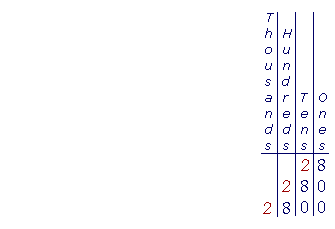|
POWERS OF 10 Lesson 1 Section 3 Here is our first example of a problem that not only should not require a calculator, but that we should not even have to write down. It is an example of skill in arithmetic. |
|||||||||||||||||||||||||||||
|
|||||||||||||||||||||||||||||

To understand this, look at 28 in the figure, and let us push each digit one place left, so that we have 280. 280 is then ten times 28, because each digit's place value is now ten times more. (In 28, the '2' tells how many tens, but in 280 it tells how many hundreds.) Similarly, 2800 = 100 × 28. Knowing that is an example of skill in arithmetic, which means to be able to do a problem with the most To be honest, we can do almost every problem with a calculator. Yet the student should wonder, What problems should not require a calculator? What problems should an educated person not even have to write down! Multiplying a number by 10 or 100 is such a problem, and throughout these pages we will emphasize others. We will emphasize that arithmetic, rather than something we're supposed to do on paper, is something we do naturally in our head. (See the Introduction.) Example 2. 608 is 608 ones. How much are 608 tens? 608 hundreds? 608 thousands? Answers. "608 tens" is 608 × 10. That is the meaning of multiplication (Lesson 8). 608 tens therefore are 6,080. Simply add on a 0. 608 hundreds = 608 × 100 = 60,800. Add on two 0's. 608 thousands = 608 × 1000 = 608,000. Add on three 0's. Example 3. a) 50 ones are equal to how many tens? Answer. 50 ones are simply 50, or 5 tens. b) 50 tens are how many hundreds? Answer. 50 tens = 500. (Add on a 0.) 50 tens are 5 hundreds. c) 50 hundreds are how many thousands? Answer. 50 hundreds = 5000. (Add on two 0's.) 50 hundreds are 5 thousands. |
|||||||||||||||||||||||||||||
|
|||||||||||||||||||||||||||||
Problem. Reduce this fraction to its lowest terms:
Answer. To reduce a fraction, we must divide both the numerator and denominator by the same number. Now, if a number ends in 0, then we know that it is divisible by 10; while if a number ends in two 0's, we know that it is divisible by 100. Both 300 and 500 then are divisible by 100:
Please "turn" the page and do some Problems. or Introduction | Home | Table of Contents Please make a donation to keep TheMathPage online. Copyright © 2001-2007 Lawrence Spector Questions or comments? E-mail: themathpage@nyc.rr.com |
|||||||||||||||||||||||||||||
